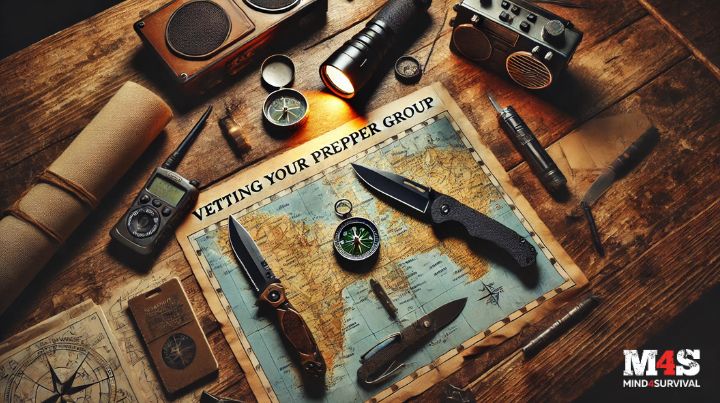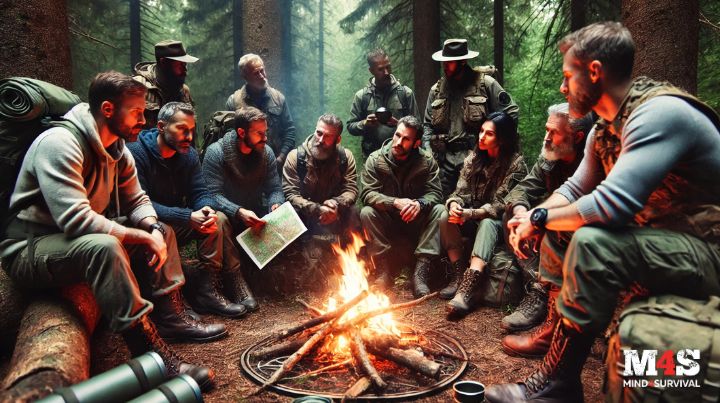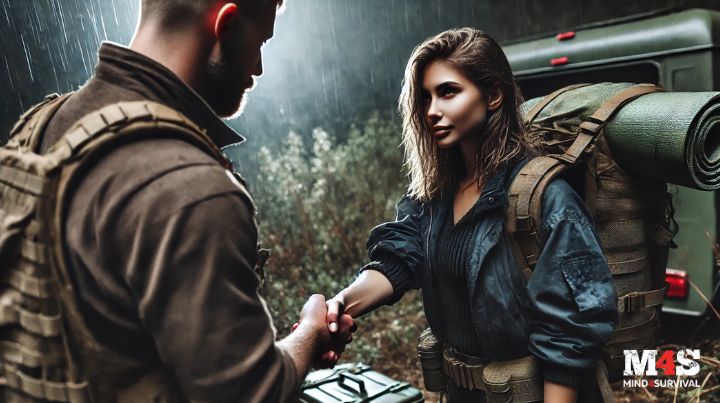Podcast: Play in new window | Download
Learning how to choose the best members for your prepper group is crucial in ensuring the long-term resilience and survival of you, your loved ones, and your preparedness group. The people you bring into your circle should have useful skills, align with your values, contribute positively to the group dynamic, and be trustworthy in high-pressure situations. A well-vetted team member enhances security, cooperation, and overall preparedness, while the wrong ones can create division, drain resources, compromise safety and security, and weaken the group.
This guide provides a structured approach to evaluating potential members, helping you identify those who will strengthen your preparedness efforts. From initial contact to full membership, each step is designed to assess a candidate’s mindset, skills, reliability, and ability to work well within your team. By taking the time to evaluate new members thoroughly, you are more likely to build a cohesive, capable group that can see you through virtually any emergency scenario.
The Benefits of a Structured Vetting Process
Having a structured approach to vetting members benefits the group in several ways. By filtering out unreliable or uncommitted individuals early on, you save time and energy that would otherwise be wasted on the wrong people. Additionally, a thorough evaluation process ensures that every member brings something valuable to the table, whether it’s skills, knowledge, or resources. A well-vetted team strengthens the group’s overall resilience, improving everyone’s chances of thriving in a crisis.
A careful selection process also creates opportunities for training and collaboration. Even if candidates lack certain skills, their enthusiasm and willingness to learn can be a great asset. Engaging new members in training exercises not only builds their competence but also strengthens group cohesion. Ensuring that each member is capable and committed sets the foundation for an adaptable and well-prepared group for any scenario.
The Structured Approach
So, how do you size someone up to determine if they are a good fit? Here’s a structured approach to evaluating potential members for your preparedness team.
1. Initial Contact and First Impressions
When you first meet a potential member, start by assessing their general demeanor and attitude. Consider these factors:
- Mindset and Attitude: Are they serious about preparedness, or is it just a passing interest?
- Communication Skills: Do they speak clearly, listen well, and engage in meaningful conversation?
- Openness to Learning: Are they receptive to new ideas, or do they insist they already know everything?
- First Impressions: Do they seem like someone you could trust in a crisis?
2. Getting to Know Them Informally
Before diving into deeper evaluations, start with casual interactions:
- Invite Them to Group Activities: Attend public preparedness meetups, gun range trips, or survival skills workshops together.
- Observe Social Dynamics: How do they interact with others? Are they respectful and cooperative?
- Gauge Their Enthusiasm: Do they show genuine interest, or are they just tagging along?
3. Testing Their Skills & Practical Abilities
Once they’ve shown initial promise, it’s time to see what they bring to the table:
- Medical Knowledge: Do they have first-aid or trauma care skills?
- Security & Defense: Are they familiar with firearms, hand-to-hand combat, or defensive tactics?
- Food Production & Storage: Can they garden, hunt, or preserve food?
- Engineering & Repairs: Do they know how to fix vehicles, radios, or infrastructure?
- Navigation & Communication: Can they read maps, use radios, or establish secure lines of communication?
4. Physical and Mental Readiness
Survival situations can be demanding. Assess their ability to handle stress and exertion:
- Physical Fitness: Can they carry heavy loads, hike long distances, and work under pressure?
- Stamina & Endurance: Are they able to sustain effort over long periods?
- Medical Conditions: Do they manage health issues responsibly, or could they be a liability?
- Mental Toughness: Do they stay calm under pressure, or do they panic?
5. Evaluating Their Commitment
A preparedness group requires dedication. Look for signs of long-term commitment:
- Consistency: Are they actively improving their skills and resources over time?
- Preparedness Mentality: Do they train regularly and contribute ideas?
- Family & Dependents: Will their family also be involved, and how will that affect group dynamics?
- Location Stability: Are they rooted in the area, or are they prone to relocation?

6. Assessing Personality and Social Fit
Even a highly skilled individual can be a liability if they don’t mesh well with others:
- Ego & Arrogance: Do they take advice well, or are they always “right”?
- Conflict Resolution Skills: Can they handle disagreements maturely?
- Reliability: Can they be counted on to follow through?
- Drama-Free Mentality: Do they bring unnecessary personal issues into the group?
7. Background and Trustworthiness
Trust is the backbone of any preparedness group. Before granting full membership, verify their background:
- Criminal History: Have they committed crimes that could pose a risk to the group?
- Loyalty & Integrity: Have they betrayed others in the past?
- OpSec Awareness: Do they understand operational security, or do they talk too much?
- Past Group Experience: Have they worked well in teams before?
8. Gradual Inclusion and Full Membership
Once they’ve passed all previous steps, introduce them in stages:
- Limited Involvement: Allow them to participate in minor roles before full access.
- Trust, but Verify: Keep an eye on their behavior over time.
- Assign Responsibilities: Give them small tasks to see how they handle responsibility.
- Full Membership: If they prove reliable, integrate them fully into the group.
9. Red Flags to Watch For
No matter how great someone seems, certain behaviors should be deal-breakers:
- Freeloading Mentality: Expecting to benefit without contributing.
- Unstable Behavior: Excessive paranoia, aggression, or mood swings.
- Dishonesty: If they lie about small things, they’ll lie about big things.
- Lack of Commitment: Showing up inconsistently or making excuses.
Pitfalls to Avoid and How to Overcome Them
While a structured vetting process has many advantages, there are potential pitfalls that groups should actively work to avoid. One of the biggest challenges is the time-intensive nature of properly assessing individuals. A rushed vetting process may lead to bringing in someone unreliable, while an overly long process might discourage potentially valuable members. To mitigate this, establish a balanced timeline that allows for thorough evaluation without unnecessary delays.
Another common pitfall is relying too much on skill assessments while overlooking interpersonal dynamics. Even highly skilled individuals can be detrimental if they create tension within the group. To counter this, focus not only on what a person can do but also how they interact with others. Regular training exercises and social interactions can help gauge whether someone fits well within the team. Additionally, be mindful of confirmation bias—don’t let personal preferences cloud your judgment when evaluating a candidate.
Security risks also pose a significant threat. A poorly vetted member who lacks operational security awareness could expose group plans or resources to outsiders, compromising safety. The best way to avoid this is to emphasize OpSec from the start and ensure that new members understand the importance of discretion. Trust should be built gradually, with access to sensitive information granted in stages as a candidate proves their reliability. By staying vigilant and structured, you can minimize risks and create a strong, cohesive, and dependable preparedness group.
The Bottom Line on Sizing Someone Up for Your Preparedness Group
Building a preparedness group is about more than just gathering skilled individuals—it’s about fostering trust, reliability, and teamwork. A strong, well-vetted team enhances the likelihood of success in any crisis, while a poorly assembled group can create unnecessary risks and vulnerabilities. By carefully evaluating potential members, you ensure that each person contributes positively and aligns with the group’s long-term goals.
A methodical vetting process may take time, but the investment pays off in the form of a stronger, more resilient community. Remember to balance skill assessment with social dynamics, prioritize operational security, and gradually integrate new members. With patience and diligence, you can create a preparedness group that is not only capable but also cohesive and dependable.
Take your time, be selective, and build a resilient, skilled, and trustworthy group.
Stay safe,

Read the full article here



